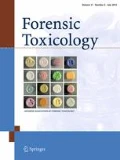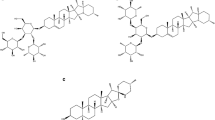Abstract
A detailed procedure has been established for simultaneous analysis of aconitine, mesaconitine, hypaconitine, and jesaconitine in whole blood using liquid chromatography-tandem mass spectrometry (LC-MS-MS). The method uses a new unique polymer column (Shodex ODP2 HP-4B) for separation, which enabled the injection of relatively crude organic extracts without complicated pretreatments. Quantitation was made by mass chromatography with each product ion referenced against dextromethorphan as internal standard. Aconitine and its three analogues showed good linearity over the range of 1.25–40 ng/ml; the detection limits were 0.3–0.5 ng/ml. Validation data including accuracy, precision, and recovery rates are presented. To further validate the present method, the mixture of aconitine, mesaconitine, and hypaconitine (0.2 mg each) was orally administered to rats, and the concentrations of the three compounds in whole blood specimens were measured 15, 30, and 45 min after dosing; their concentrations in rat whole blood were 0.74–18.3 ng/ml. The present LC-MS-MS method is very effective for simple simultaneous analysis of aconitine and its analogues in forensic and clinical toxicology.
Similar content being viewed by others
References
Mizugaki M, Ito K (2005) Aconite toxins. In: Suzuki O, Watanabe K (eds) Drugs and poisons in humans: a handbook of practical analysis. Springer, Berlin Heidelberg New York, pp 455–467
Elliot SP (2002) A case of fatal poisoning with the aconitine plant: quantitative analysis in biological fluid. Sci Justice 42:111–115
Pullela R, Young L, Gallagher B, Avis SP, Randell EW (2008) A case of fatal aconitine poisoning by monkshood ingestion. J Forensic Sci 53:491–494
Van Landegheim AA, De Letter EA, Lambert WE, Van Peteghem CH, Piette MHA (2007) Aconitine involvement in an unusual homicide case. Int J Legal Med 121:214–219
Ohta H, Seto Y, Tsunoda N, Takahashi Y, Matsuura K, Ogasawara K (1998) Determination of Aconitum alkaloids in blood and urine samples II. Capillary liquid chromatographicfrit fast atom bombardment mass spectrometric analysis. J Chromatogr B 714:215–221
Fujita Y, Fujita M, Niitsu H, Oikawa K, Terui K, Akatsu T, Kikuchi M, Sato N, Aoki H, Takahashi K, Endo S (2005) A simple and rapid method for analysis of Aconitium alkaloids in serum and urine using liquid chromatography electrospray ionization mass spectrometry. J Trad Med 22:49–54
Kaneko R, Hattori S, Furuta S, Hamajima M, Hirata Y, Watanabe K, Seno H, Ishii A (2006) Sensitive analysis of aconitine, hypaconitine, mesaconitine and jesaconitine in human body fluids and Aconitum tubers by LC/ESI-TOF-MS. J Mass Spectrom 41:810–814
Wong S-K, Tsui S-K, Kwan S-Y (2002) Analysis of proprietary Chinese medicines for the presence of toxic ingredients by LC/MS/MS. J Pharm Biomed Anal 30:161–170
Beike J, Frommherz L, Wood M, Brinkman B, Köhler H (2004) Determination of aconitine in body fluids by LC-MSMS. Int J Legal Med 118:289–293
Beyer J, Peters FT, Kraemer T, Maurer HH (2007) Detection and validated quantification of toxic alkaloids in human blood plasma-comparison of LC-APCI-MS with LC-ESI-MS/MS. J Mass Spectrom 42:621–633
Wang Z, Wang Z, Wen J, He Y (2007) Simultaneous determination of three Aconitum alkaloids in urine by LC-MS-MS. J Pharm Biomed Anal 45:145–148
Zhang F, Tang M-H, Chen L-J, Li R, Wang X-H, Duan J-G, Zhao X, Wei Y-Q (2008) Simultaneous quantitation of aconitine, mesaconitine, hypaconitine, benzoylaconine, benzoylmesaconine and benzoylhypaconine in human plasma by liquid chromatography-tandem mass spectrometry and pharmacokinetics evaluation of “SHEN-FU” injectable powder. J Chromatogr B 873:173–179
Hattori H, Ito K, Iwai M, Arinobu T, Mizutani Y, Kumazawa T, Ishii A, Suzuki O, Seno H (2007) Rapid analysis of sertraline, fluvoxamine, and paroxetine in serum specimens by LC-MS-MS using a new polymer column. Forensic Toxicol 25:100–103
Hattori H, Arinobu T, Iwai M, Masuda K, Suzuki O, Seno H (2005) Analysis of butyrophenones in whole blood specimens by LC/MS/MS using a new polymer column. Jpn J Forensic Toxicol 23:13–17
Author information
Authors and Affiliations
Corresponding author
Rights and permissions
About this article
Cite this article
Hattori, H., Hirata, Y., Hamajima, M. et al. Simultaneous analysis of aconitine, mesaconitine, hypaconitine, and jesaconitine in whole blood by LC-MS-MS using a new polymer column. Forensic Toxicol 27, 7–11 (2009). https://doi.org/10.1007/s11419-008-0060-z
Received:
Accepted:
Published:
Issue Date:
DOI: https://doi.org/10.1007/s11419-008-0060-z




